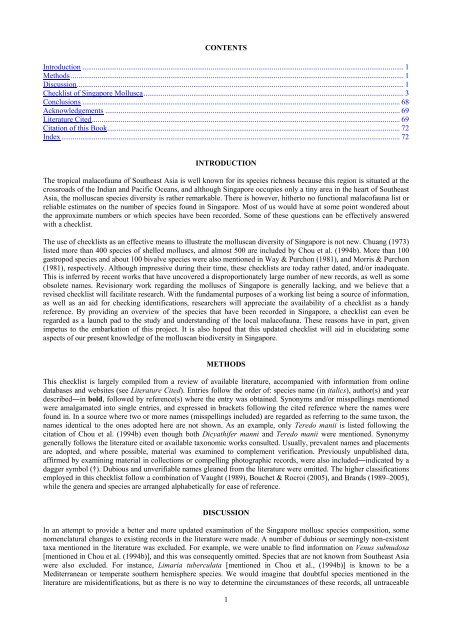a preliminary checklist of the molluscs of singapore - Raffles ...
a preliminary checklist of the molluscs of singapore - Raffles ...
a preliminary checklist of the molluscs of singapore - Raffles ...
Create successful ePaper yourself
Turn your PDF publications into a flip-book with our unique Google optimized e-Paper software.
CONTENTS<br />
Introduction ........................................................................................................................................................................ 1<br />
Methods .............................................................................................................................................................................. 1<br />
Discussion........................................................................................................................................................................... 1<br />
Checklist <strong>of</strong> Singapore Mollusca........................................................................................................................................ 3<br />
Conclusions ...................................................................................................................................................................... 68<br />
Acknowledgements .......................................................................................................................................................... 69<br />
Literature Cited................................................................................................................................................................. 69<br />
Citation <strong>of</strong> this Book......................................................................................................................................................... 72<br />
Index................................................................................................................................................................................. 72<br />
INTRODUCTION<br />
The tropical malac<strong>of</strong>auna <strong>of</strong> Sou<strong>the</strong>ast Asia is well known for its species richness because this region is situated at <strong>the</strong><br />
crossroads <strong>of</strong> <strong>the</strong> Indian and Pacific Oceans, and although Singapore occupies only a tiny area in <strong>the</strong> heart <strong>of</strong> Sou<strong>the</strong>ast<br />
Asia, <strong>the</strong> molluscan species diversity is ra<strong>the</strong>r remarkable. There is however, hi<strong>the</strong>rto no functional malac<strong>of</strong>auna list or<br />
reliable estimates on <strong>the</strong> number <strong>of</strong> species found in Singapore. Most <strong>of</strong> us would have at some point wondered about<br />
<strong>the</strong> approximate numbers or which species have been recorded. Some <strong>of</strong> <strong>the</strong>se questions can be effectively answered<br />
with a <strong>checklist</strong>.<br />
The use <strong>of</strong> <strong>checklist</strong>s as an effective means to illustrate <strong>the</strong> molluscan diversity <strong>of</strong> Singapore is not new. Chuang (1973)<br />
listed more than 400 species <strong>of</strong> shelled <strong>molluscs</strong>, and almost 500 are included by Chou et al. (1994b). More than 100<br />
gastropod species and about 100 bivalve species were also mentioned in Way & Purchon (1981), and Morris & Purchon<br />
(1981), respectively. Although impressive during <strong>the</strong>ir time, <strong>the</strong>se <strong>checklist</strong>s are today ra<strong>the</strong>r dated, and/or inadequate.<br />
This is inferred by recent works that have uncovered a disproportionately large number <strong>of</strong> new records, as well as some<br />
obsolete names. Revisionary work regarding <strong>the</strong> <strong>molluscs</strong> <strong>of</strong> Singapore is generally lacking, and we believe that a<br />
revised <strong>checklist</strong> will facilitate research. With <strong>the</strong> fundamental purposes <strong>of</strong> a working list being a source <strong>of</strong> information,<br />
as well as an aid for checking identifications, researchers will appreciate <strong>the</strong> availability <strong>of</strong> a <strong>checklist</strong> as a handy<br />
reference. By providing an overview <strong>of</strong> <strong>the</strong> species that have been recorded in Singapore, a <strong>checklist</strong> can even be<br />
regarded as a launch pad to <strong>the</strong> study and understanding <strong>of</strong> <strong>the</strong> local malac<strong>of</strong>auna. These reasons have in part, given<br />
impetus to <strong>the</strong> embarkation <strong>of</strong> this project. It is also hoped that this updated <strong>checklist</strong> will aid in elucidating some<br />
aspects <strong>of</strong> our present knowledge <strong>of</strong> <strong>the</strong> molluscan biodiversity in Singapore.<br />
METHODS<br />
This <strong>checklist</strong> is largely compiled from a review <strong>of</strong> available literature, accompanied with information from online<br />
databases and websites (see Literature Cited). Entries follow <strong>the</strong> order <strong>of</strong>: species name (in italics), author(s) and year<br />
described―in bold, followed by reference(s) where <strong>the</strong> entry was obtained. Synonyms and/or misspellings mentioned<br />
were amalgamated into single entries, and expressed in brackets following <strong>the</strong> cited reference where <strong>the</strong> names were<br />
found in. In a source where two or more names (misspellings included) are regarded as referring to <strong>the</strong> same taxon, <strong>the</strong><br />
names identical to <strong>the</strong> ones adopted here are not shown. As an example, only Teredo manii is listed following <strong>the</strong><br />
citation <strong>of</strong> Chou et al. (1994b) even though both Dicyathifer manni and Teredo manii were mentioned. Synonymy<br />
generally follows <strong>the</strong> literature cited or available taxonomic works consulted. Usually, prevalent names and placements<br />
are adopted, and where possible, material was examined to complement verification. Previously unpublished data,<br />
affirmed by examining material in collections or compelling photographic records, were also included―indicated by a<br />
dagger symbol (†). Dubious and unverifiable names gleaned from <strong>the</strong> literature were omitted. The higher classifications<br />
employed in this <strong>checklist</strong> follow a combination <strong>of</strong> Vaught (1989), Bouchet & Rocroi (2005), and Brands (1989–2005),<br />
while <strong>the</strong> genera and species are arranged alphabetically for ease <strong>of</strong> reference.<br />
DISCUSSION<br />
In an attempt to provide a better and more updated examination <strong>of</strong> <strong>the</strong> Singapore mollusc species composition, some<br />
nomenclatural changes to existing records in <strong>the</strong> literature were made. A number <strong>of</strong> dubious or seemingly non-existent<br />
taxa mentioned in <strong>the</strong> literature was excluded. For example, we were unable to find information on Venus subnudosa<br />
[mentioned in Chou et al. (1994b)], and this was consequently omitted. Species that are not known from Sou<strong>the</strong>ast Asia<br />
were also excluded. For instance, Limaria tuberculata [mentioned in Chou et al., (1994b)] is known to be a<br />
Mediterranean or temperate sou<strong>the</strong>rn hemisphere species. We would imagine that doubtful species mentioned in <strong>the</strong><br />
literature are misidentifications, but as <strong>the</strong>re is no way to determine <strong>the</strong> circumstances <strong>of</strong> <strong>the</strong>se records, all untraceable<br />
1
















